VPIP
In Texas Hold’em, VPIP (Voluntarily Put in Pot) is the percentage of players who voluntarily put chips into the pot pre-flop, whether by calling or raising, and represents their participation in the game. (Other than the BB) you are participating unless you choose to fold in the initial betting. A player with a low ratio would be considered tight, while a player with a high ratio would be considered loose.
In reality, VPIP depends on the opponent’s strategy (for example, the VPIP will be different for the same player if he plays against a player who always goes all-in and if he plays against a player who always limps in), so it cannot be explained by the hand selection of each individual player. However, in this article, we will assume that it is determined only by the hand selection criteria of the player and consider what the hand ranges of players with different VPIPs will be.
Even with the same VPIP, there may be different types of players, such as players who prefer high-ranking hands (hands containing A or K) and players who prefer suited hands, but basically, a rational player will choose to play more hands with a high probability of winning and fold lower-ranking hands. Therefore, there is a certain degree of rationality in the method of determining the hands to enter in order of the probability of winning so as to match the specified VPIP. For example, let’s find out what the hand ranges are when VPIP is 5, 10, 15, 20, 25, 30, 40, 50, and 60-70%. The winning probabilities applied were calculated for two players and six players. The former might be seen as a player who prefers high-ranking hands, while the latter is a player who prefers suited hands. In reality, the hand range will be wider for SB and BB, and the hand range will differ depending on the position, but for the purposes of this article we will ignore differences due to position.
Using the 2-player Win Rate Table
- VPIP=5%
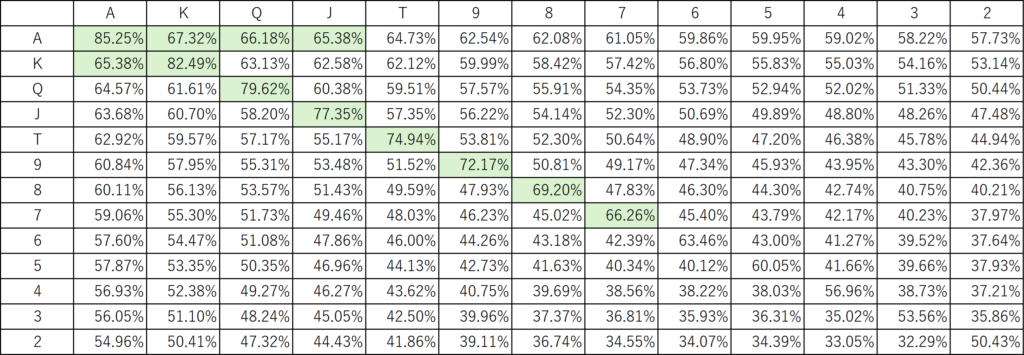
- VPIP=10%
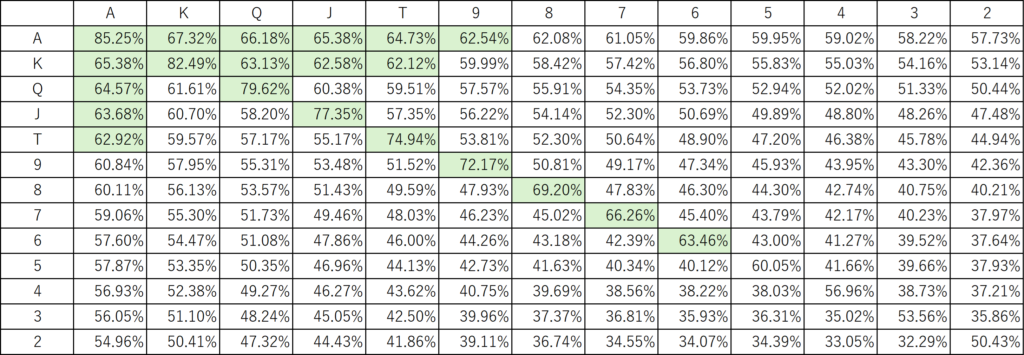
- VPIP=15%
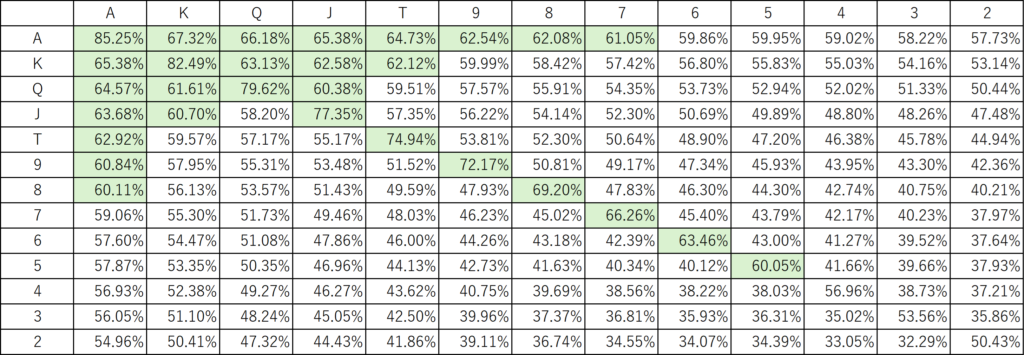
- VPIP=20%
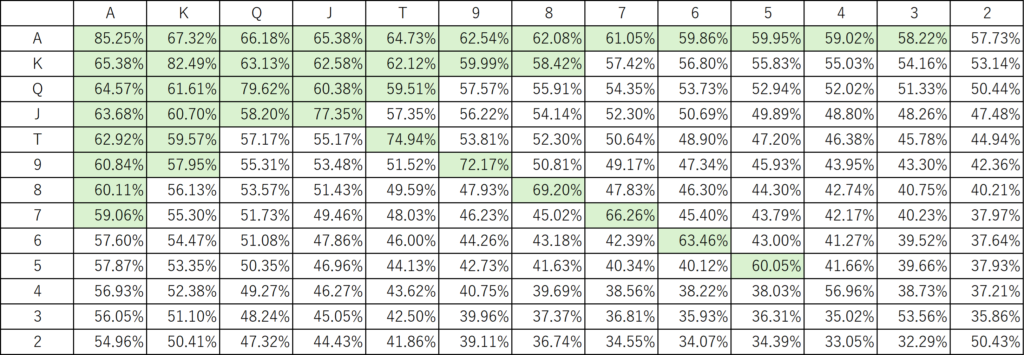
- VPIP=25%
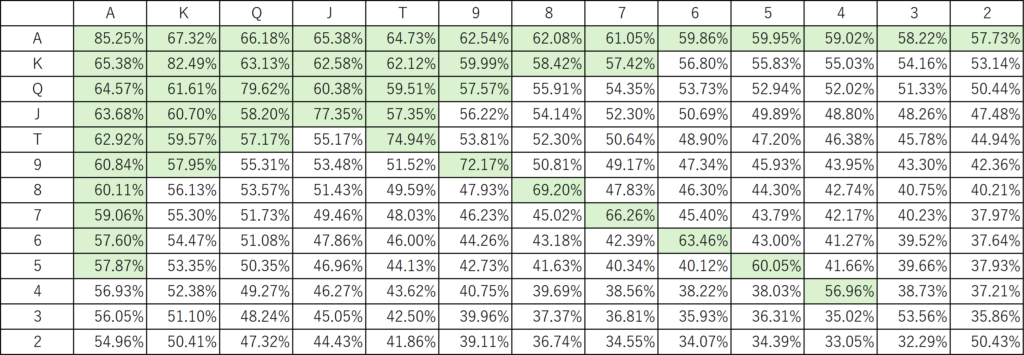
- VPIP=30%
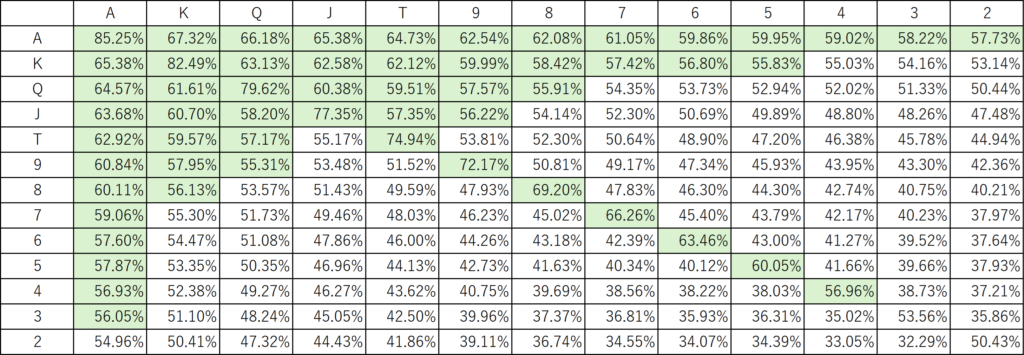
- VPIP=40%
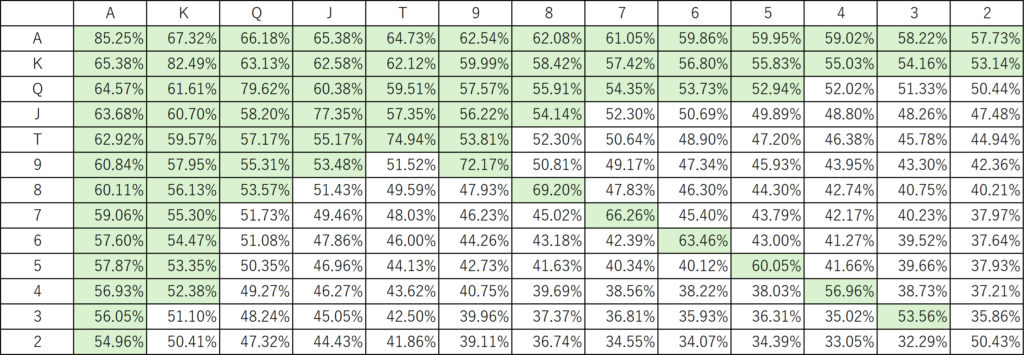
- VPIP=50%
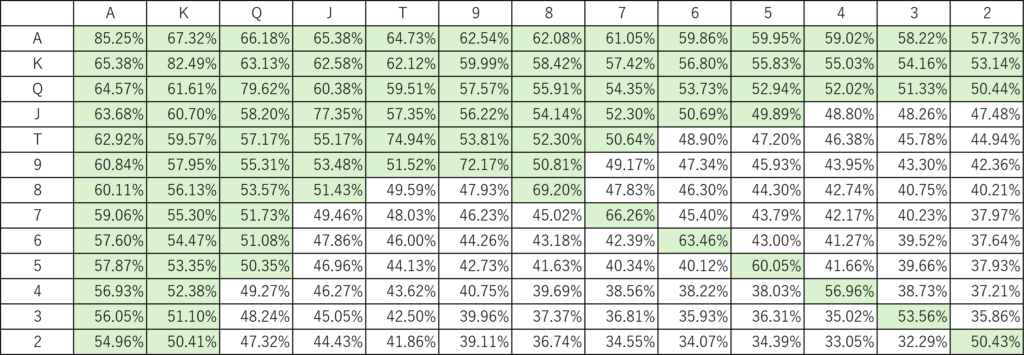
- VPIP=66.66% (2/3)
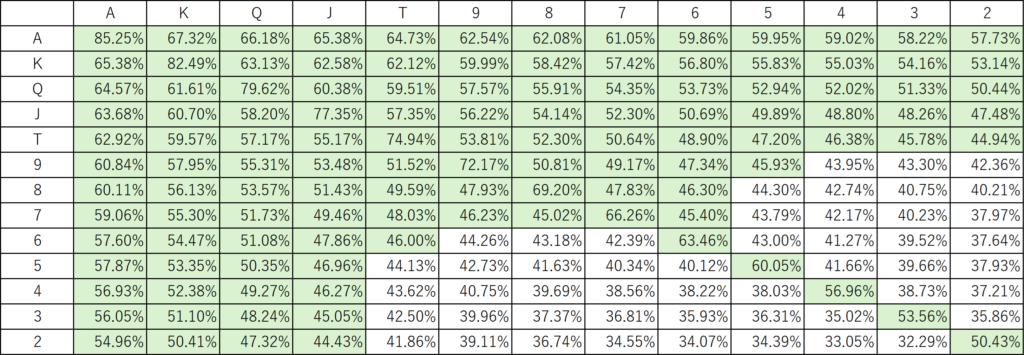
Using the 6-player Win Rate Table
- VPIP=5%
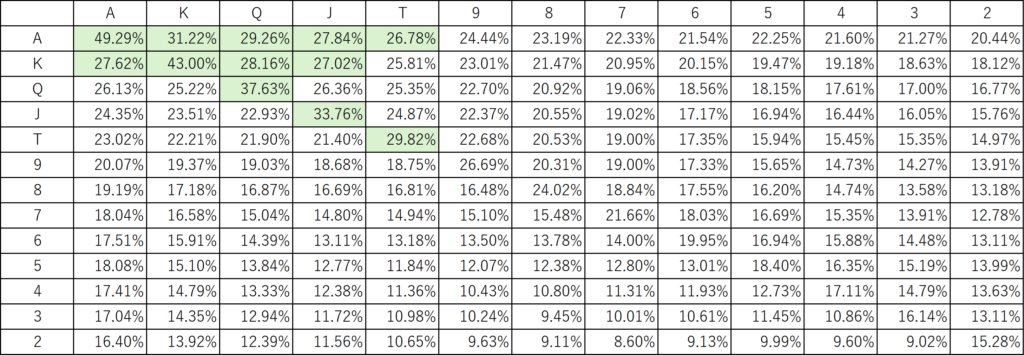
- VPIP=10%
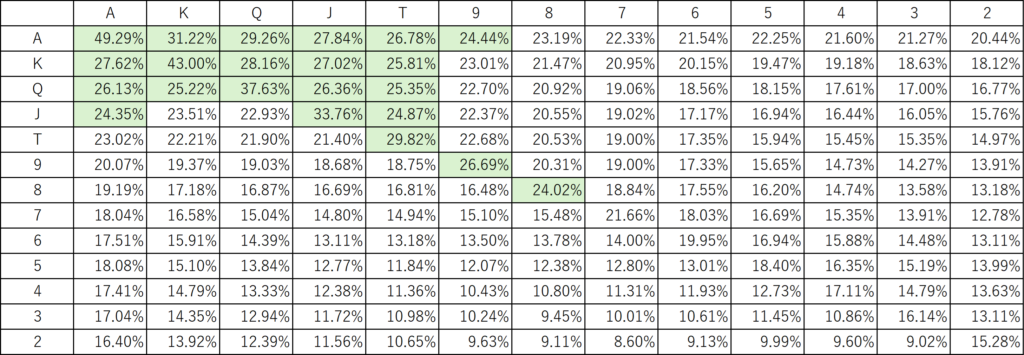
- VPIP=15%
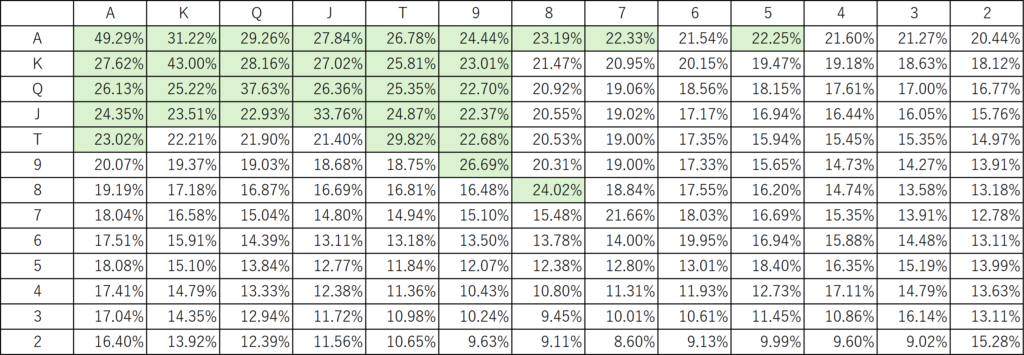
- VPIP=20%
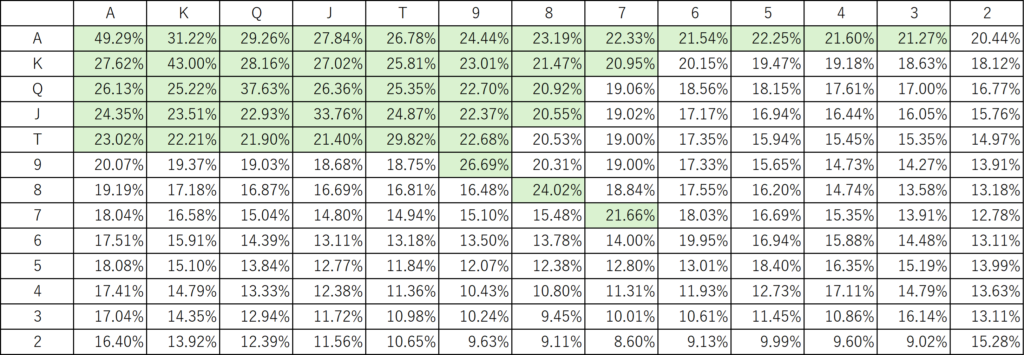
- VPIP=25%
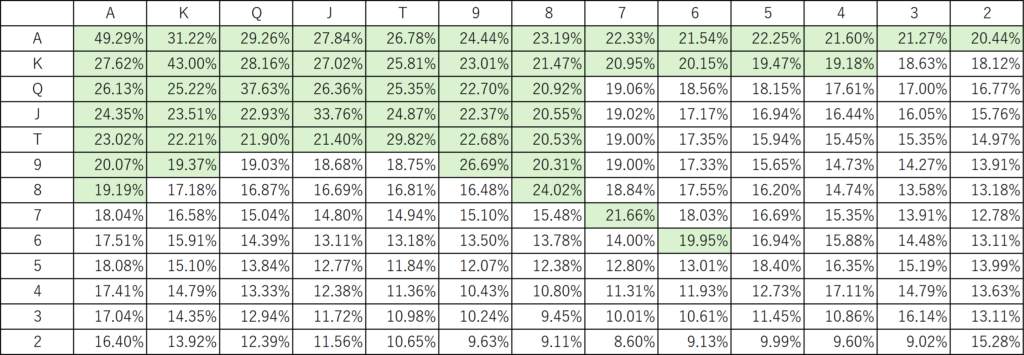
- VPIP=30%
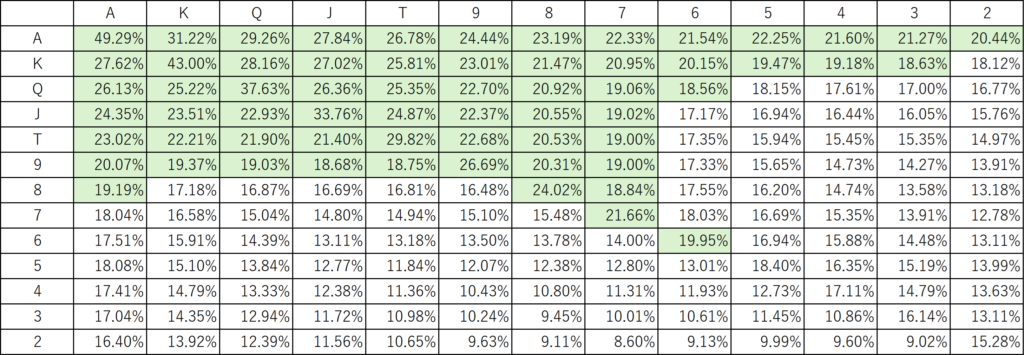
- VPIP=40%
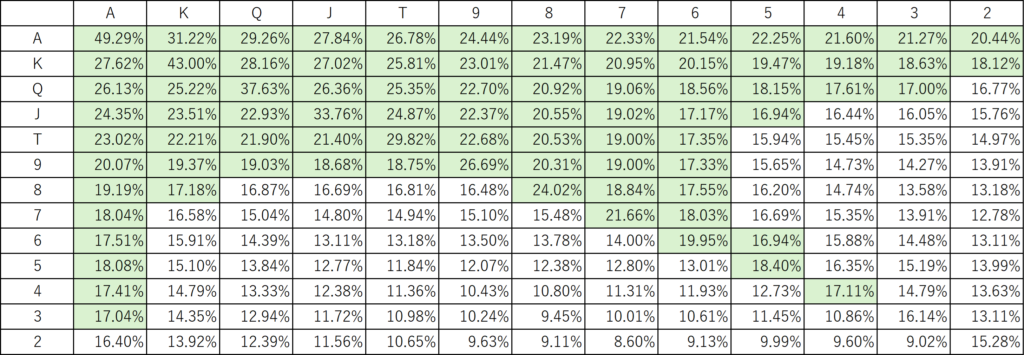
- VPIP=50%
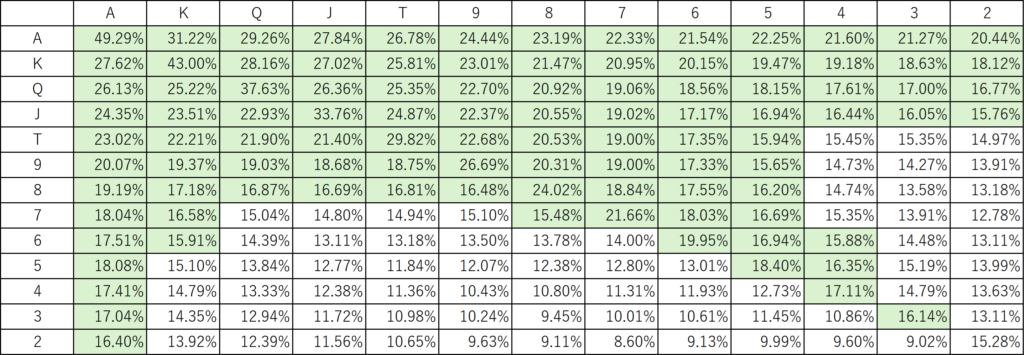
- VPIP=66.66% (2/3)
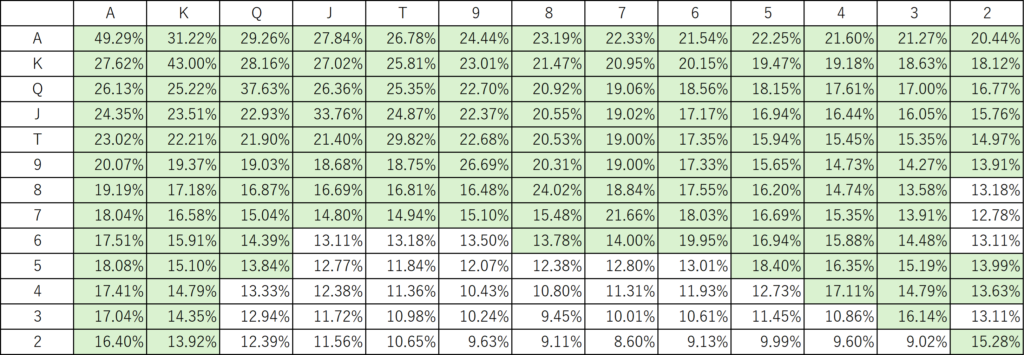
Pre-flop Player Behavior Model
You may wonder what the point of making such a table is, but when creating a computer model of a player’s pre-flop behavior, the motivation is to want to represent a wide range of behavior with as few parameters as possible. The idea is that a fair range of behavioral models can be expressed using just two parameters: VPIP and the number of player using the probability of winning table. Of course, being able to define actions for individual cards in a hand would increase expressiveness, but it would be tedious to assign an action pattern to every single card in a hand.
When modeling player behavior preflop, you will need to define hand ranges for each of the following. Assuming the stack is around 100bb, the combinations of the number of bets before actively raising and the number of bets to passively call are as follows.
- 5bet/5bet…Raise all-in, passively call all-in.
- 4bet/5bet…Raise to 4bet passively call all-in.
- 4bet/4bet…Raise to 4bet, passively call to 4bet.
- 3bet/4bet…Raise to 3bet, passively call to 4bet.
- 3bet/3bet…Raise to 3bet, passively call to 3bet.
- 2bet/3bet…Raise to 2bet, passively call to 3bet.
- 2bet/2bet…Raise to 2bet, passively call to 2bet.
- 1bet/2bet…Limp in, passively call to 2bet.
- 1bet/1bet…Limp in and fold if raised.
- Fold
In reality, if you believe that you will call all-in with a 3-bet hand and will never limp in, then we can simplify it to the following points:
- 3bet…Raise to 3bet, passively call all-in.
- 2bet/3bet…Raise to 2bet, passively call to 3bet.
- 2bet/2bet…Raise to 2bet, passively call to 2bet.
- Fold
In theory, 3bet/5bet or 2bet/4bet could also be considered, but these do not seem like very rational strategies, so we can probably leave them out.
Configuration Example
Let’s consider a configuration example. This is probably a hand range that a player with a VPIP of around 20% would tend to adopt.
- 5bet/5bet…KK
- 4bet/5bet…AA,QQ,JJ
- 3bet/4bet…The hand range in VPIP 5% with 2 players win rate table and hands not included in the above ranges.
- 3bet/3bet…The hand range in VPIP 10% with 2 players win rate table and hands not included in the above ranges.
- 2bet/3bet…The hand range in VPIP 15% with 2 players win rate table and hands not included in the above ranges.
- 2bet/2bet…The hand range in VPIP 20% with 2 players win rate table and hands not included in the above ranges.
- Fold…otherwise
The reason KK is better than AA is because it is considered acceptable to force your opponent to fold preflop. There is a risk of being called by a hand that has A, so it is okay to fold if you can (although this often leads to unfortunate results if the other player has AA). On the other hand, in the case of AA, you would rather have other players go all-in as well, so it may be better not to go all-in preflop carelessly. Regardless of whether narrowing the range to this extent will make it strong or not, it may give the impression that you are playing the game seriously.
By the way, I use a range that is fully suited to beginner players, which is close to the image above as well as:
- 1bet/2bet…The hand range in VPIP 50% with 6 players win rate table and hands not included in the above ranges. All of suited, connected hands are also included.
and my VPIP is around 60% (my opponents are often around 50-70%). In games with many beginner-looking players, many players don’t make 3-bet even when they have hands that would actually make 3 or more, so we can see the flop cards with many hands. I limp in about 2/3 of the time, but I feel like it’s a relatively comfortable range to play. With these hands, you will often see the flop and immediately fold, but if the flop turns out to be a good one, you can stab your opponent’s strong hand and take a bigger pot. Of course, I wouldn’t do this in a tournament or when there’s a limper-killer player around, but I think 8. will eventually disappear as the opponents get stronger.
Preflop Bluffing
In addition to having a pre-determined strategy for your hand, you might also decide to 3-bet pre-flop a certain percentage of the time, even if you don’t actually have a 3-bet hand, in order to get your opponent to fold. It is not uncommon to see a player who 3-bet end up with 72o. Well, this might be going too far, but we might be able to represent preflop bluffs by giving a parameter that represents the probability of 3-betting and 4-betting with a 2-bet/3-bet hand.
Also, if a player judges that their opponent’s hand is moderately strong (they will call up to 3 bets but will fold if they are all-in), there are quite a few players who use the strategy of bluffing all-in to steal bets from other players. In the example settings from the previous section, if you go all-in with QQ or JJ, you will always be at a disadvantage (no one will go all-in preflop except for KK), so you should not call a 5-bet.However, the idea can be given that these are hands that are easy to catch a bluff all-in with, so it would be better to call even a 5-bet. Since there is a fair chance that an all-in with around 2-bet is a bluff, in reality, it seems that there are quite a few players who call even with pocket pairs of a slightly lower ranking.
Finally, if all players up to BN or SB have folded, a player may raise a hand that would normally be folded in order to get the BB to fold. This is called blind stealing, but it is also a form of bluffing. If the BB player also sees this as a bluff, they will often reraise (called a squeeze) even if they have a weak hand as a defensive measure. However, this is an operation that is difficult to describe algorithmically, so it may be best to ignore it for the time being.
For each layer, we can model these actions by giving parameters such as the probability of bluff-raising and the probability of bluffing all-in.
Summary
By being able to calculate hand ranges based on VPIP and building a model of player behavior preflop, we might be able to try things like the following:
- The program will make assumptions about post-flop strategies and test various pre-flop strategies to see which type of player has the advantage. It may be possible to see what strategies work best when there are Ante or when there are a variety of other players.
- In the previous post, we assumed that the opponent does not choose their hand when going all-in preflop, but in this article we will examine what strategy is best to adopt if we narrow this down to a certain VPIP.
Of course, my main goal is to build a behavioral model of NPCs to be used as opponents in the game, but I would also like to be able to try out these kinds of experiments on the blog.
Postscript: Bonus
As a bonus, the tables shown in Sections 2 and 3 can now be displayed as specified VPIP and win rate tables.
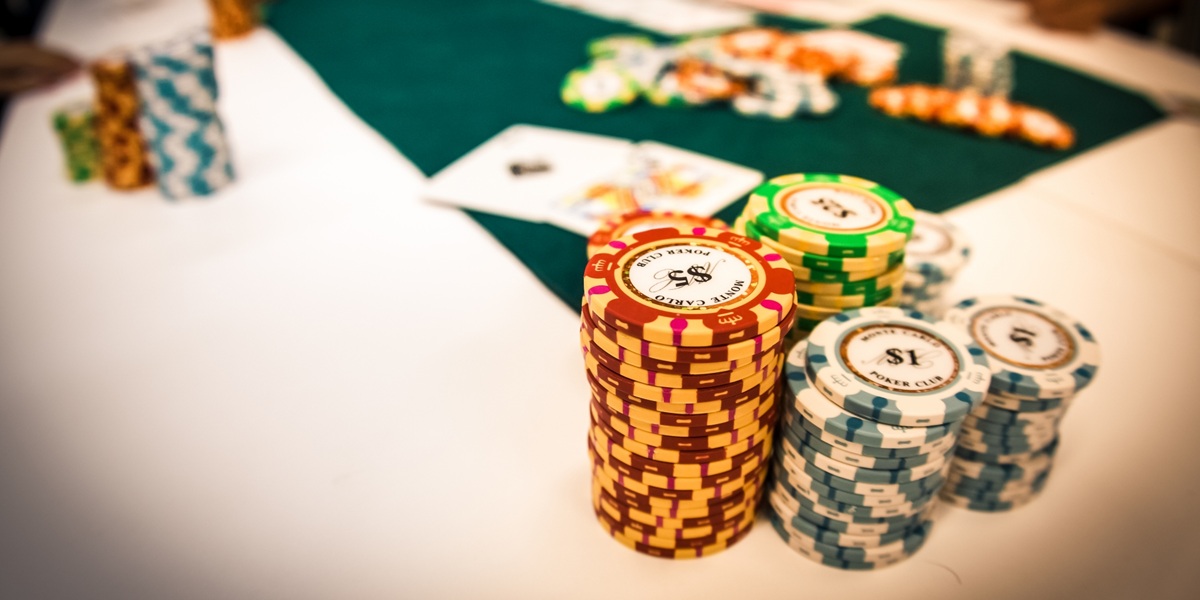



Comments